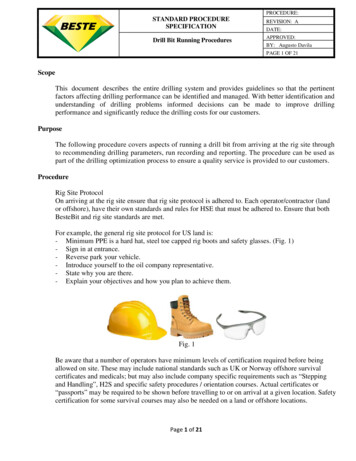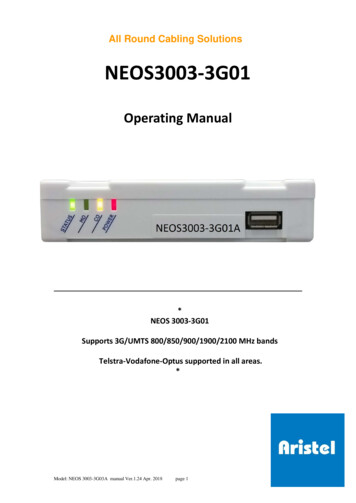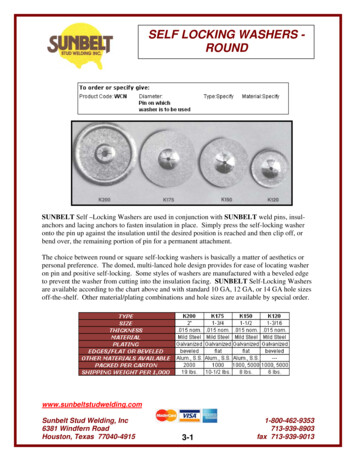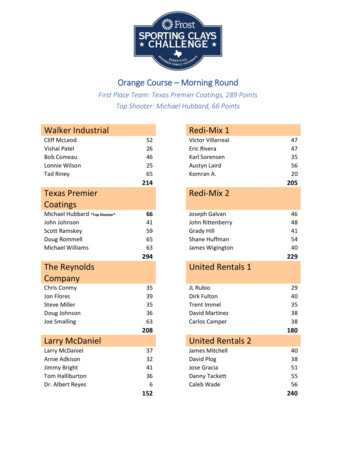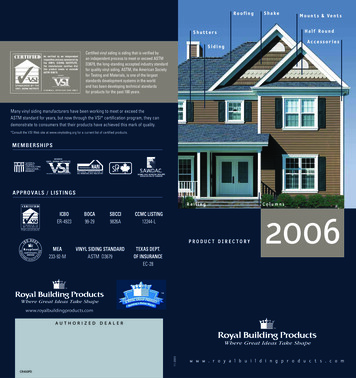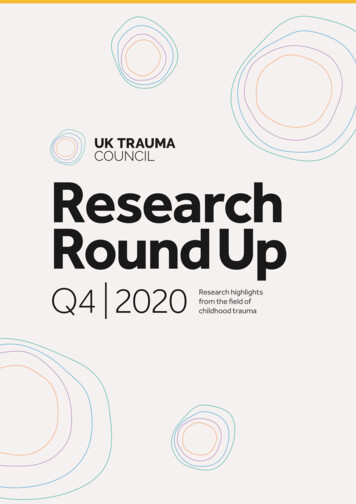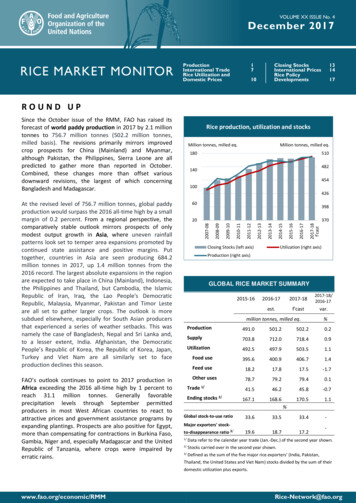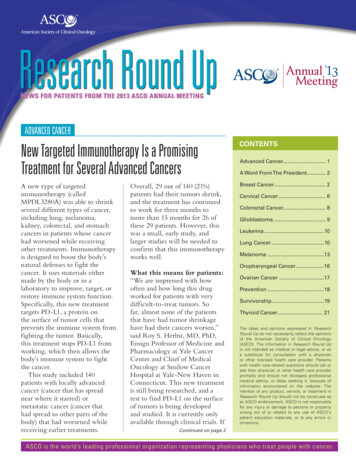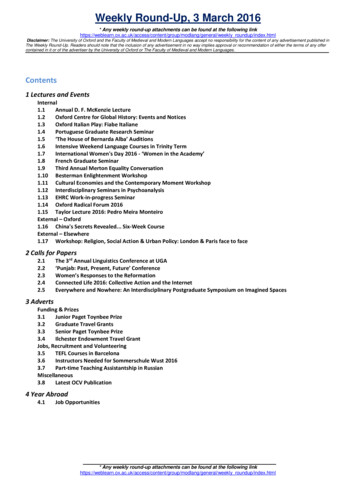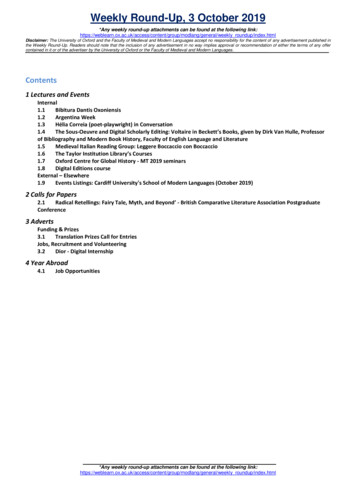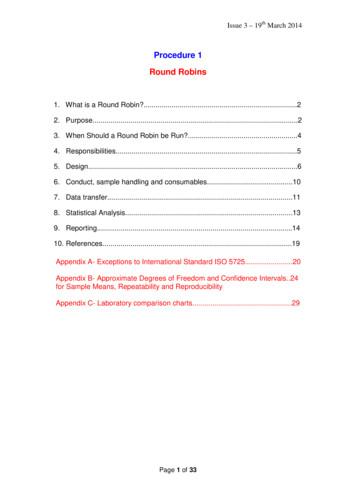
Transcription
Issue 3 – 19th March 2014Procedure 1Round Robins1. What is a Round Robin?.22. Purpose.23. When Should a Round Robin be Run?.44. Responsibilities.55. Design.66. Conduct, sample handling and consumables.107. Data transfer.118. Statistical Analysis.139. Reporting.1410. References.19Appendix A- Exceptions to International Standard ISO 5725.20Appendix B- Approximate Degrees of Freedom and Confidence Intervals.24for Sample Means, Repeatability and ReproducibilityAppendix C- Laboratory comparison charts.29Page 1 of 33
Issue 3 – 19th March 2014Procedure 1Round RobinsThis procedure replaces former Procedure 1 - Conduct of Precision TestingProgrammes and Procedure 2 - Collection, Transfer and Reporting ofReference Test Data.1. What is a Round Robin?A “round robin” is a test programme in which a number of laboratories testidentical samples of a number of test materials in order (primarily) todetermine the precision (repeatability and reproducibility) of each reportedparameter in a test method.ExampleTable 1 shows data from a round robin to determine the precision of a testmethod that measures the kinematic viscosity of used engine oils. Four usedoil samples A, B, C and D were tested in duplicate at 12 laboratories.After the rejection of several abnormal sets of data points (shaded in yellow)as “outliers” using the methods detailed in International Standard ISO 5725-2[1] and Appendix A of this procedure, the repeatability r and reproducibility R,as defined in Procedure 4, were estimated to be r 0.0314 y 0.275; R 0.243 y 5.43where y denotes the true viscosity of the oil under test.(Note: this round robin was conducted in 2002 and only tested 4 samples; thecurrent procedure requires a minimum of 5 samples in order to determine rand R as functions of y)2. PurposeRound robin programmes are conducted in order to understand and quantifythe variation in each reported parameter in a test method. They may also beused to measure the performances of particular fluids or fluid batches and/orto investigate the severity 1 of a test method.1Severity: In CEC, the term “severity” is used rather loosely to express the position(s) of themean(s) of set(s) of test results on a particular sample or samples. A test is described asbecoming more “severe” if changes in mean test results occur that are indicative of worseningtest fluid performance and “mild” if the changes are indicative of better performance.Laboratories can also be described as “severe” or “mild” relative to their peers if there aresystematic differences in their test results.Page 2 of 33
Issue 3 – 19th March 2014Table 1. Data from a round robin to determine the precision of a test methodthat measures the kinematic viscosity of used engine oils (SG-L-083).KV100, cStLab 2Lab 2Lab 3Lab 3Lab 4Lab 4Lab 5Lab 5Lab 6Lab 6Lab 7Lab 7Lab 8Lab 8Lab 9Lab 9Lab 10Lab 10Lab 11Lab 11Lab 12Lab 12Lab 13Lab .8076.3772.5771.6465.6576.38For new tests, the key objective is to establish the precision and produceprecision statements. Round robins can also be used to monitor the precisionof existing tests and update their precision statements if appropriate (seeProcedure 3).The precision statistics (repeatability and reproducibility) determined from theround robin can then be used to evaluate the method’s suitability for measuring the performance ofproducts to check the achievement of repeatability and reproducibility targets(see Procedure 3 for details).The statistical analysis may also be used: to compare laboratories in terms of their precision (repeatability), severityand ability to rank fluids consistently with their peersPage 3 of 33
Issue 3 – 19th March 2014 to measure the performance of new reference samples/batches (e.g. to settest monitoring targets and control limits; see Procedure 2) or new types offluid to check for severity and precision changes (perhaps after hardware orother method changes) to study the impact of other factors on the precision or severityRound robin studies may also be used to try and understand the sources ofvariability in test results in order to improve a method’s precision. Laboratoriesmight therefore be requested to supply additional information about theirinstallation, or to gather additional data during each test (e.g. on ambient orengine-running conditions) in the round robin.Most tests consist of producing a phenomenon, e.g. wear, and thenmeasuring it. For investigative purposes, the measurement aspect can bestudied independently, for example in rating workshops. Round robins canalso be carried out solely on the measurement part of a test procedure. Forexample, the increase in viscosity as the soot content of a fresh oil builds to6% is one of the key outputs from the PSA-DV4 engine test (SG-L-093). Theviscosity increase is measured using the measurement method studied inTable 1 (SG-L-083).The precise objectives of round robin programmes must agreed at a WorkingGroup meeting prior to the commencement of the study and shall be recordedin the minutes.3. When Should a Round Robin be Run?When a new test method is being developed, the first round robin will normallybe conducted at the end of the single-laboratory test development phasewhen the method is rolled out to other laboratories.Subsequent round robins should then be conducted on a regular basis,typically annually, until the method is stable unless otherwise agreed by theWorking Group and Management Board.All laboratories in the Working Group must participate in round robins.Once the method is considered stable and no major changes in severity orprecision are being observed, the group may reduce the frequency of roundrobins, and use test monitoring data from the CEC-TMS or ATC-ERCreference database, as appropriate, to monitor severity and precision (seeProcedure 2). However migration to test monitoring may prove impracticalwhen reference fluid batches have too short a shelf life to establish targetsand thereafter collect reasonably lengthy series of repeated measurements.Page 4 of 33
Issue 3 – 19th March 2014If major changes are made to the test method, a round robin will be needed tocheck for changes in precision and/or severity.Mini round-robin programmes may also be required to determine theproperties of new reference fluid batches. These might involve just onesample and limited numbers of evaluations, the size of the round robin beingparticularly constrained in expensive engine tests.Pilot studiesWhen the single-laboratory test development stage is complete, the workinggroup may conduct pilot inter-laboratory programme(s) at a small number ofnew laboratories toverify the operational details of the test and that operators can followthe test procedurecheck sample distribution and handling proceduresroughly estimate laboratory-to-laboratory variability and repeatability atother laboratoriesThe working group may also decide to conduct a mini round robin (one test onone or two samples per laboratory) in order to obtain a preliminary estimate ofreproducibility across a wider population of laboratories.The results from a pilot programme or mini round robin may be considered asforming part of a larger round robin if the study is subsequently extended tofurther laboratories testing the same sample(s) within a reasonable period oftime.4. ResponsibilitiesThe WG (Working Group) Chairman has overall responsibility for organisingthe round robin. The chairman must ensure that the WG members set clearobjectives and time scales.All laboratory members of the WG shall take part in the round robin andprovide test results within time scale agreed.The Statistical Development Group Liaison Officer (SDG LO) shall providehelp in designing the round robin to meet the Working Group’s objectives.The WG Chairman may appoint a Working Group Database Administrator(WG DBA) to collate round robin and test monitoring results. The SDG LOand the WG DBA will agree the format in which the data will be transferred(see section 7 below).Page 5 of 33
Issue 3 – 19th March 2014The SDG LO will perform the statistical analysis of the final results andpresent these to the WG.The SDG LO will provide other analyses and advice to the WG that may beuseful for improving their understanding of the test.5. DesignNumber of laboratoriesAll laboratory members of the WG shall take part in round robins. At least fivelaboratories/stands are required in order to obtain a reasonably preciseestimate of reproducibility, but it is preferable to have more. The number oflaboratories/stands participating in a round robin shall be stated in anyprecision statement based on the results.If the total number of laboratories in the WG is less than five, then the roundrobin can and should still take place. In such circumstances, statistical adviceshould be sought on how any general reproducibility figure should beinterpreted, and appropriate caveats must be given in the precision statement.Number of samplesThe number of samples shall be sufficient to span the population of fluidsfalling within the scope of the test method, and it should also cover the likelyranges of each reported parameter. Issues to be considered might include, forexample, oil viscosity grade, fuel composition, presence/absence of additives,etc. Methods should correlate with field performance. The sample set maythus include CEC reference fluids, test development fluids and other fluidsneeded to widen the span, any of which may subsequently be chosen asreference fluids.If any variation in precision with performance level has been observed inprevious programmes, or is expected from experience with similar tests orfrom engineering judgement, then at least five samples need to be tested ifthe aim is to express repeatability r and reproducibility R as functions of level.The number of samples required will be greater when the relationshipsbetween r and R and performance level are nonlinear.It is recognised, however, that many CEC tests, particularly engine tests, areexpensive and the cost of testing five samples at every laboratory may beprohibitive. In such circumstances, a smaller number of samples may betested; a minimum of two is required. Fewer samples might also be tested inperiodic round robins on stable methods, or when linear relationships betweenprecision and level, or suitable variance stabilising transformations2 have2International Standard ISO 4259 [2] Annex E details a number of such transformations, e.g.log or arcsin.Page 6 of 33
Issue 3 – 19th March 2014been found in previous exercises. Reference fluids will normally be the onestested in such studies.Table 2. 95% confidence limits for the true repeatability as a function of ameasured value r and its associated degrees of freedom.d.f.123456789101520253095% confidence limits0.446r - 31.910r0.521r - 6.285r0.566r - 3.729r0.599r - 2.874r0.624r - 2.453r0.644r - 2.202r0.661r - 2.035r0.675r - 1.916r0.688r - 1.826r0.699r - 1.755r0.739r - 1.548r0.765r - 1.444r0.784r - 1.380r0.799r - 1.337rThe multipliers in this table may also be used to calculate 95% confidence limits for the truereproducibility as a function of a measured value RWhen fewer than five samples are tested, however, it may subsequentlyprove impossible to infer the values of the repeatability r and reproducibility Rfor other samples at different performance levels. In such circumstances,precision statements should simply quote the values of r and R for thesamples tested.When precision depends on level, the working group may base itsrepeatability and reproducibility targets on one particular sample in the roundrobin (see Procedure 3). If the method is used in a specification, the chosensample will typically be of borderline performance.Number of repeatsIn order to estimate repeatability, each sample will normally need to be testedtwice at each laboratory. Further repeats may be required to obtain areasonably precise estimate of repeatability if the number of participatinglaboratories is small. The total d.f. (degrees of freedom) for repeatability on aparticular sample isRepeatability d.f. for single sample Total number of tests on that sample – No. of laboratories testing that sampleTable 2 may be used to determine 95% confidence limits for the truerepeatability and reproducibility of a test method as a function of their degreesPage 7 of 33
Issue 3 – 19th March 2014Table 3. Measurements of inlet valve cleanliness rated on a 0-10 scale in aSG-F-005 round robin.Laboratory12346891011121415718Sample ATest 1Test 27.557.707.827.268.557.687.507.73Sample BTest 1Test .669.937.989.507.339.329.389.10of f
as “outliers” using the methods detailed in International Standard ISO 5725-2 [1] and Appendix A of this procedure, the repeatability r and reproducibility R, as defined in Procedure 4, were estimated to be . r yR y 0.0314 0.275; 0.243 5.43. where y denotes the true viscosity of the oil under test. (Note: this round robin was conducted in 2002 and only tested 4 samples; the .
